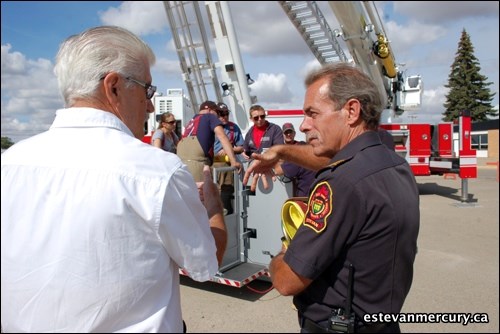It will be the king of the firefighting and rescue fleet for sure and although the price tag is $1.3 million, its versatility will make it a cost-effective piece of equipment.
That's the word coming down from the recent first-day training session that Estevan Fire Rescue Service personnel participated in at the parking lot in front of the Souris Valley Aquatic and Leisure Centre last Wednesday.
The T-rex aerial fire truck, built on a Rosenbauer chassis in Minnesota, will be dispatched quite regularly while one of the older pumper trucks will be semi-retired, said deputy Chief Dale Feser.
Better protection services is what it's all about since the new truck has aerial capacity to take fire and rescue personnel up as high as nine storeys if necessary. Gaining good heights in rapid fashion as opposed to the time-consuming and physically exhausting tasks of climbing ladders is the first and most obvious advantage. Being able to attack a fire at a better angle is also an obvious attraction for those fighting fires, said Chief Ron Tocker. The same goes for water rescues.
The highly computerized unit can be stabilized quickly under nearly any condition including steep grades, and will cover nearly all contingencies including deployment for underground or over water rescues.
The aerial hooks have the strength to allow the lift of two cars at the same time, right up and out of a tight area, or removal of a wall, in one fell swoop.
While the operating costs go up, the savings on insurance and increased efficiencies will more than make up for any perceived losses, say those who are intimately involved in the truck's deployment.
"It will take about a month to train everyone on this," said Tocker, noting that the Fire Rescue Service currently has 31 volunteers available to answer the calls for assistance in either fighting fires or performing rescues.
The articulating aerial bucket is launched using up to six people at a time, including the personnel in the bucket itself.
"The articulating boom allows us to deploy it well above or below grade," said Feser.
"It registers wind speeds and weather conditions and has manual override if needed. It has ground and bucket sensors to detect obstructions and because the ladder doesn't have to swing wide before it moves up, it can be used in congested areas," Feser added.
The truck's automatic storage and bed section means the truck will fit nicely into the Estevan Fire Rescue station.
"We can use it close to buildings. We can respond accordingly if the fire we're fighting gets too intense; there is a hose connection right at the top of the bucket. We can work it out over water or 18 to 30 feet below grade if need be," Feser said. At its highest elevation the aerial bucket can be raised to 115 feet.
"It's important to get everyone trained and up-to-speed on this unit. It will be the second pumper unit out on a first response call," said Tocker, explaining how the deployment of trucks and personnel is handled for each emergency call.
While a core unit of eight fire and rescue volunteers took turns learning how to stabilize and deploy various key elements on the new unit, Estevan Councillor Dennis Moore was prepped for a big lift into the skies along with training officer Carey Feduniw of Rocky Mountain Phoenix, the contractors for the job of training the local personnel.
After he was outfitted with a big safety belt, Moore was lifted into the skies by local fire rescue volunteer Travis Oliver.
On the second day of training, T-rex was taken to Trinity Tower, one of the highest buildings in the city at eight storeys where more aerial training was completed, including a trip to the nether regions by Mercury co-editor Chad Saxon who enjoyed the view of Estevan from a new vantage point.




